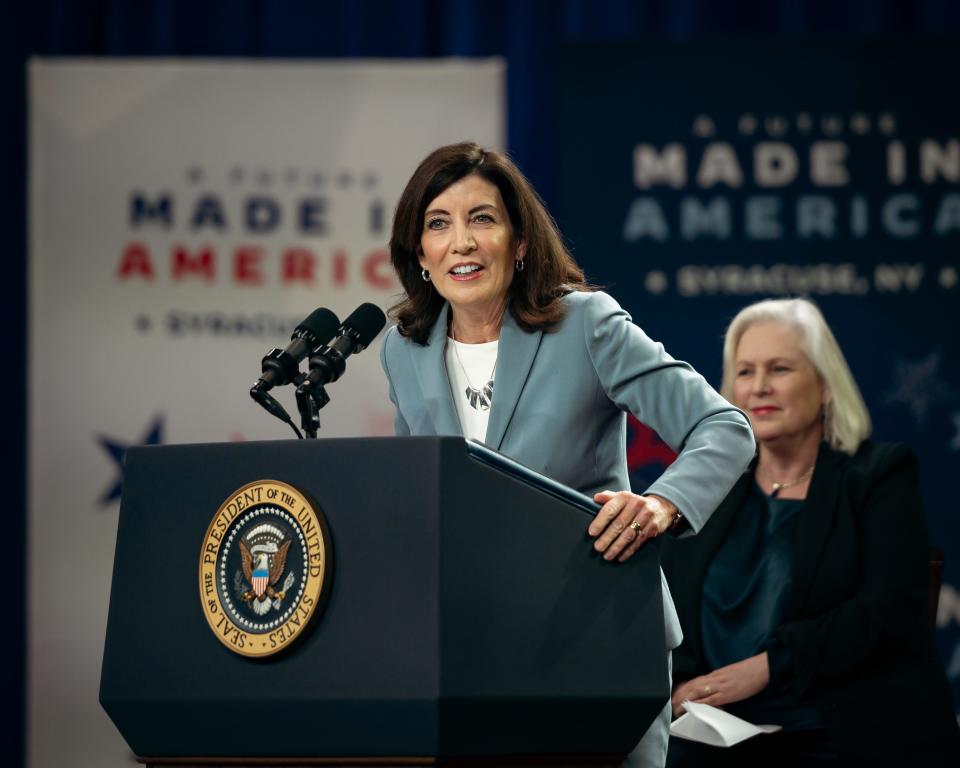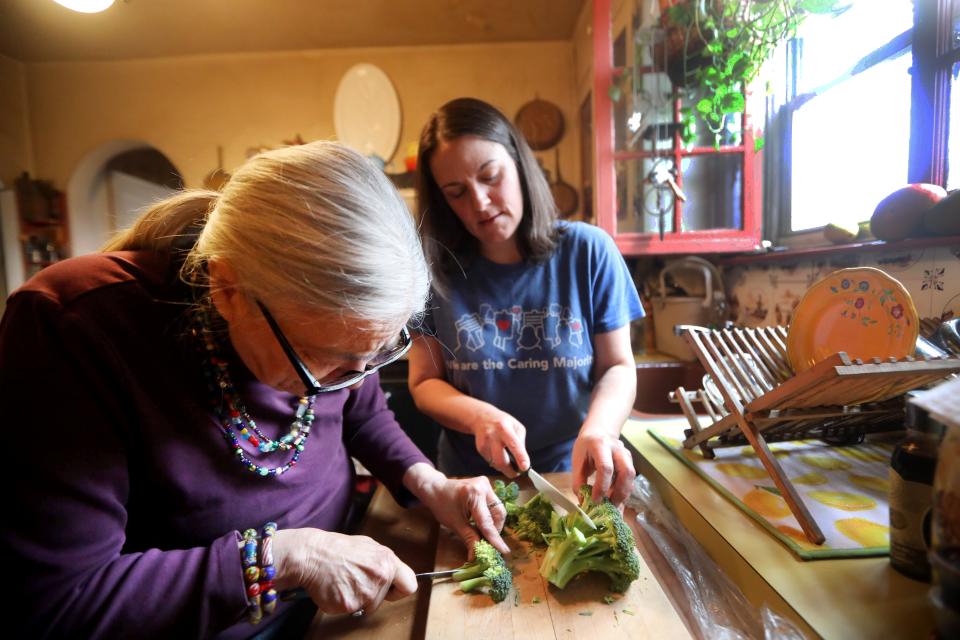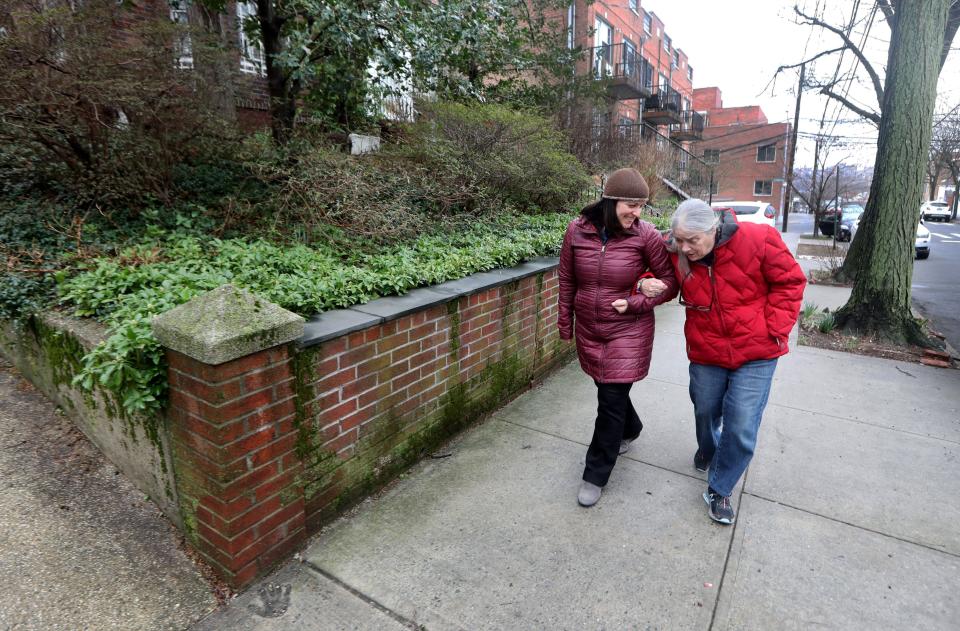NY invests in its older generations with Master Plan for the Aging. How it'll work
- Oops!Something went wrong.Please try again later.
New York is already home to one of the oldest populations in the nation – a trend that is about to speed up and put a strain on the state's resources.
Under a plan announced Friday, it aims to not only be ready to handle the challenges that will bring, but to help seniors thrive.
Gov. Kathy Hochul on Friday laid the groundwork for a New York Master Plan for Aging that will foster more collaboration and innovation to support the health and well-being of older state residents and their loved ones.
“We continue to take important steps to empower and support older New Yorkers," Hochul said, announcing she signed an executive order directing the state Department of Health and Office of Aging to lead the effort. "This Master Plan for Aging will provide us with tools to ensure our aging New Yorkers have access to quality long-term care in healthy, livable communities where they can thrive."
Shortage of home care aides:Home care crisis leaves New Yorkers without aides and families face burnout
How will the plan for the aging come together?
The two state agencies will lead a council with input from leaders in the aging fields to forge a roadmap to improve, not replace, existing efforts in a state where one-quarter of residents are expected to be 60 and older by the end of the decade.
“This is a landmark moment for New York’s older adults and all people who value healthy aging across the state,” said Nora OBrien-Suric, president of the Health Foundation for Western & Central New York, which focuses on supporting programs for children and older adults, as well as health and racial equity in health care.

The foundation helped meld more than 80 aging-focused organizations across New York into a bipartisan, independent New York Sate Master Plan for Aging Coalition. Members signed a letter last December encouraging New York to join Colorado, Texas and Massachusetts, which have already committed to a master plan for aging, as well as California, the first to finish one in January 2021.
Hochul included the idea in her State of the State address and as a line in the state budget. She signed her executive order on Older New Yorkers' Day, as well as the fourth day of National Family Caregivers Month.
“Caregiving has emerged as a central issue in aging, because of the rapid growth of the number of people who are caregivers,” said Robert Blancato, coordinator of the state master plan coalition and the national Elder Justice Coalition. “There are 40 million Americans who have some caregiving responsibilities, but we are so far behind in recognizing that from a policy perspective.”
The state plan will focus on how services are coordinated, delivered and financed to better meet the needs of older adults and their families.
Nursing homes' staffing struggles:Nursing homes can't find caregivers. Sending nursing assistants back to school could help
Long COVID and caregiving:Long COVID survivors seek support, treatment from NY and federal programs
NY has been building toward plan for older adults for years
In 2017, New York became the first state to join the AARP Network of Age-Friendly Communities, and works with the nonprofit organization to make the state more attractive for housing, transportation, jobs and other needs important to those 50 and older who make up 36% of the state population and plow more than $700 billion a year into the state economy.
Adults older than 60 provide nearly $500 million hours of community service each year at an economic value of $13.8 billion. Roughly two-thirds also own homes and have no mortgage, the Hochul administration said in making the Friday announcement.

The state Department of Health created an Office of Aging and Long-Term Care in July to address the administration's goal of "a long-term care system that is accessible, effective and affordable, a system that will recognize the unique needs and expectations of each of the individuals it serves," said state Health Commissioner Dr. Mary T. Bassett, who will lead the Master Plan for Aging Council.
Plan to address community wellness, as well as long-term care
Blancato, also a member of the national AARP board, told The Buffalo News that only 5% of older American adults live in nursing homes, underlining the need of aging in place with necessary services.
“This is really about providing the necessary infrastructure to allow them to stay in New York, whether it's better housing, better roads, better services, whatever it may be,” he said. “Support for caregivers is at the heart and soul because it’s one of the bigger challenges in the field of aging.”
He said he also hopes the plan will address more effective ways to confront elder abuse, neglect and exploitation.
People live longer than they used to, but the idea behind this plan is to create a longer "health span" for older New Yorkers, allowing them to enjoy a higher quality of life for longer, said Ann Marie Cook, President and CEO of Lifespan, a Rochester-based organization that supports older adults and caregivers. Cook is on the steering committee for the Master Plan for the Aging.
"We all need to take as many preventative measures as possible, and decrease that time in which we really need a lot of supportive care," Cook said. "You have people living a really long time with chronic conditions, so if they're going to have those chronic conditions, how do we help them live their best life?"
Additionally, many older adults donate their time as volunteers and make an immense positive impact in their communities, she said, noting that Lifespan has about 300 volunteers at any given time − all of them older adults. This plan will support their ability to use their time and skills in that way if they choose, she added.

The Master Plan for Aging Coalition hopes to work closely with state agency leaders who make up the Master Plan Council.
Coalition members include leaders and members of community organizations, long-term care advocates and providers, foundations, academic institutions, groups interested in racial and socioeconomic justice, paid and family caregiver organizations, county offices for the aging, and several national aging organizations and coalitions.
Those groups hope a plan will be in place by 2024.
The clock is ticking.
Wave of aging Boomers coming
The U.S. Census Bureau estimated four years ago that there will be more adults 65 and older in America than children by 2035. The 85-and-older population will likely more than double from 6.6 million before the pandemic to 14.4 million in 2040.
“With this swelling number of older adults, the country could see greater demands for healthcare, in-home caregiving and assisted living facilities,” the Census Bureau reported. “It could also affect Social Security.”
Before the pandemic, 51% of those 65 and older lived in nine states: California (5.8 million), Florida (4.5 million), Texas (3.7 million), New York (3.3 million), Pennsylvania (2.4 million), Ohio (2 million), Illinois (2 million), Michigan (1.8 million) and North Carolina (1.8 million), according to a 2021 report from the federal Administration for Community Living.
Pressure in those states and across the country will grow in every sector, Blancato said, hitting health care, housing, transportation, insurance, business and government hardest.
That is why planning matters, he said.
“State agencies in New York are doing activities that would fit into a master plan,” Blancato said, “so it isn't like you'd have to start from scratch. What you need is to be able to coordinate what you're doing in such a way that it produces better results and outcomes.”
This story was produced through the New York & Michigan Solutions Journalism Collaborative's ongoing occasional series, Invisible Army: Caregivers on the Front Lines. The collaborative is a partnership of news organizations and universities dedicated to rigorous and compelling reporting about successful responses to social problems. The group is supported by the Solutions Journalism Network. Read related stories at nymisojo.com. The collaborative also has compiled a detailed Caregiving Resource Guide with links to online information about various issues of interest to caregivers.
This story was produced with support from the New York & Michigan Solutions Journalism Collaborative, a partnership of news organizations and universities dedicated to rigorous and compelling reporting about successful responses to social problems. The group is supported by the Solutions Journalism Network. Read related stories at nymisojo.com. The collaborative also has compiled a detailed Caregiving Resource Guide with links to online information about various issues of interest to caregivers.
This article originally appeared on New York State Team: How NY Master Plan for the Aging will work

